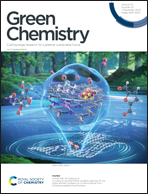In situ passivation of Fe nanoparticles exsolved from perovskite cathodes through zinc doping for CO2 electrolysis†
Abstract
Efficiently converting CO2 into value-added fuels or chemicals is a significant target for reducing CO2 emissions and achieving carbon neutrality. Solid oxide electrolysis cells (SOECs) are devices where the CO2 reduction reaction (CO2RR) takes place with high efficiency and fast kinetics at high temperatures. Since the CO2RR occurring at the cathode side is a sluggish reaction over whole electrode reactions, it is crucial to develop innovative cathode materials with high activity and good durability. Here, we demonstrate a strategy to synergistically optimize the bulk properties of Sr2Fe1.5Mo0.5O6−δ (SFM) and the morphology of the exsolved nanoparticles (NPs) to enhance the CO2RR activity, electrochemical performance, and durability. The partial replacement with zinc in the Fe-site of SFM not only increases the oxygen vacancy concentration of perovskite bulk and improves the CO2 adsorption capacity, but also passivates in situ exsolution of Fe NPs and improves the active sites on the perovskite surface, thus enhancing CO2 electrolysis performance. A novel cathode, Sr2Fe1.4Zn0.1Mo0.5O6−δ (SFZM01), used in a La0.8Sr0.2Ga0.8Mg0.2O3−δ electrolyte-supported single cell, shows a high current density of 2.74 A cm−2 at 850 °C (1.6 V) and excellent durability when operated at a current density of −1.0 A cm−2 at 750 °C. These findings can guide the development of high-activity and stability catalysts for carbon capture and utilization.



 Please wait while we load your content...
Please wait while we load your content...